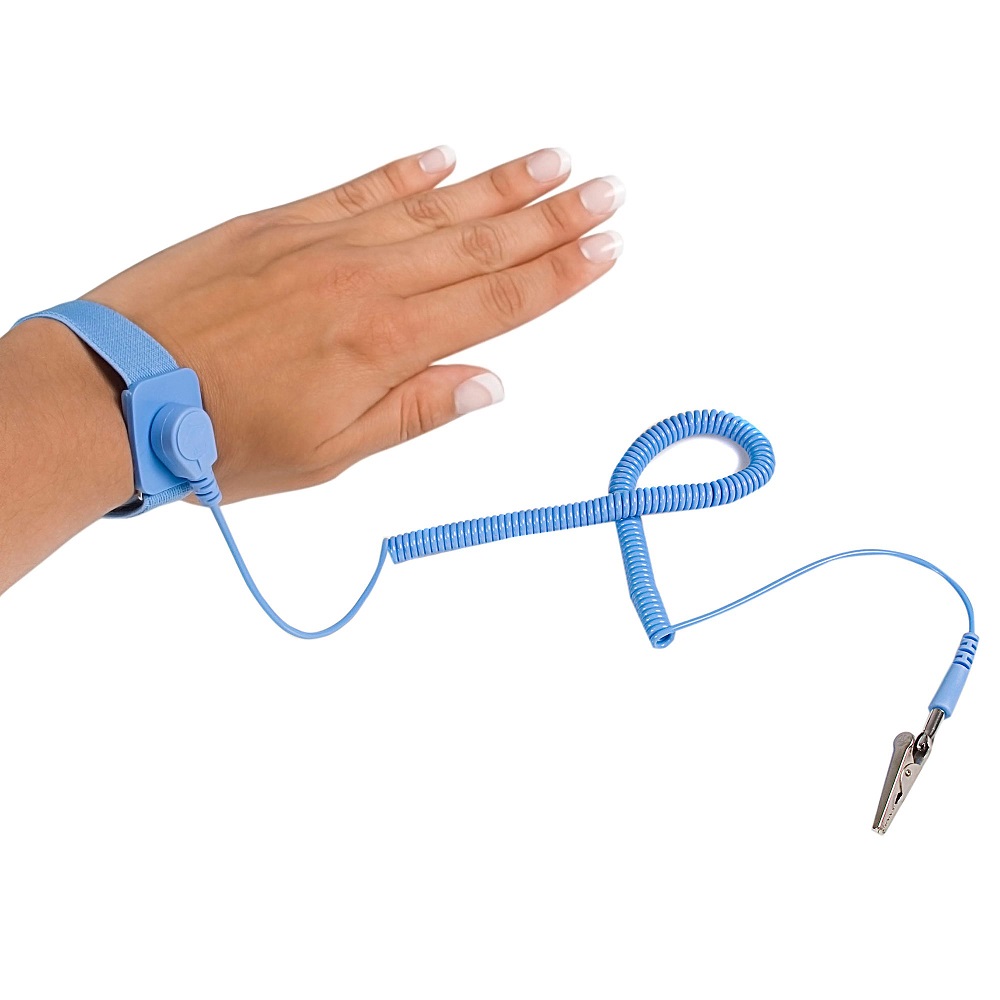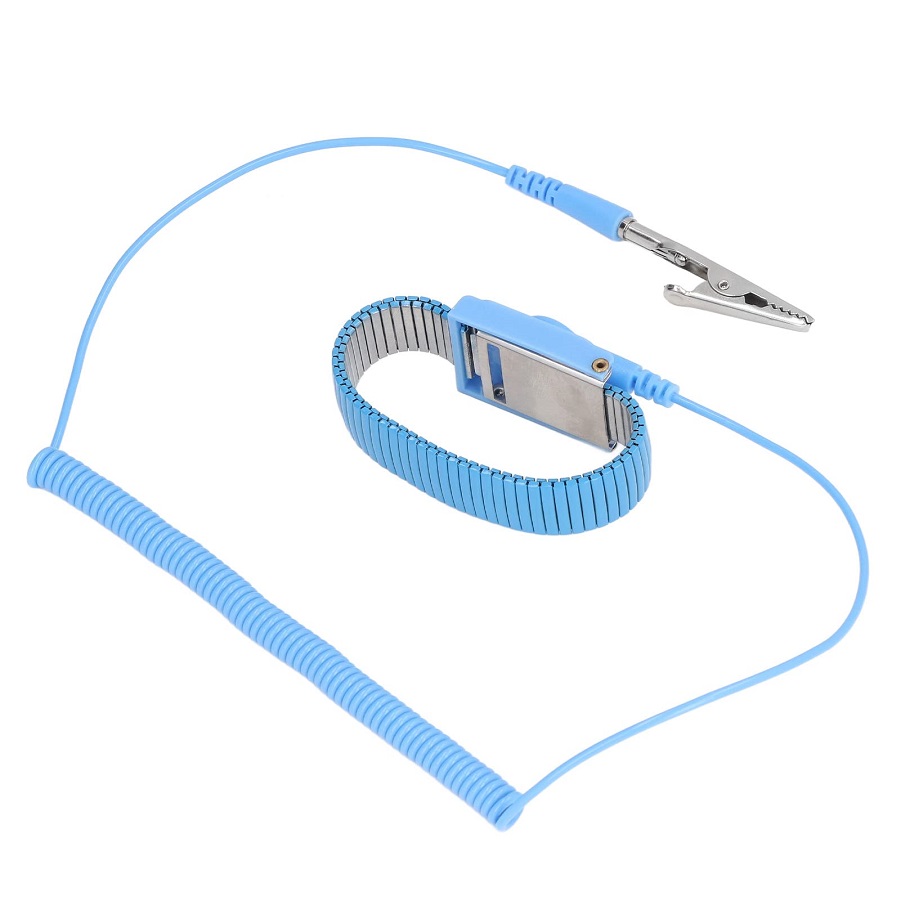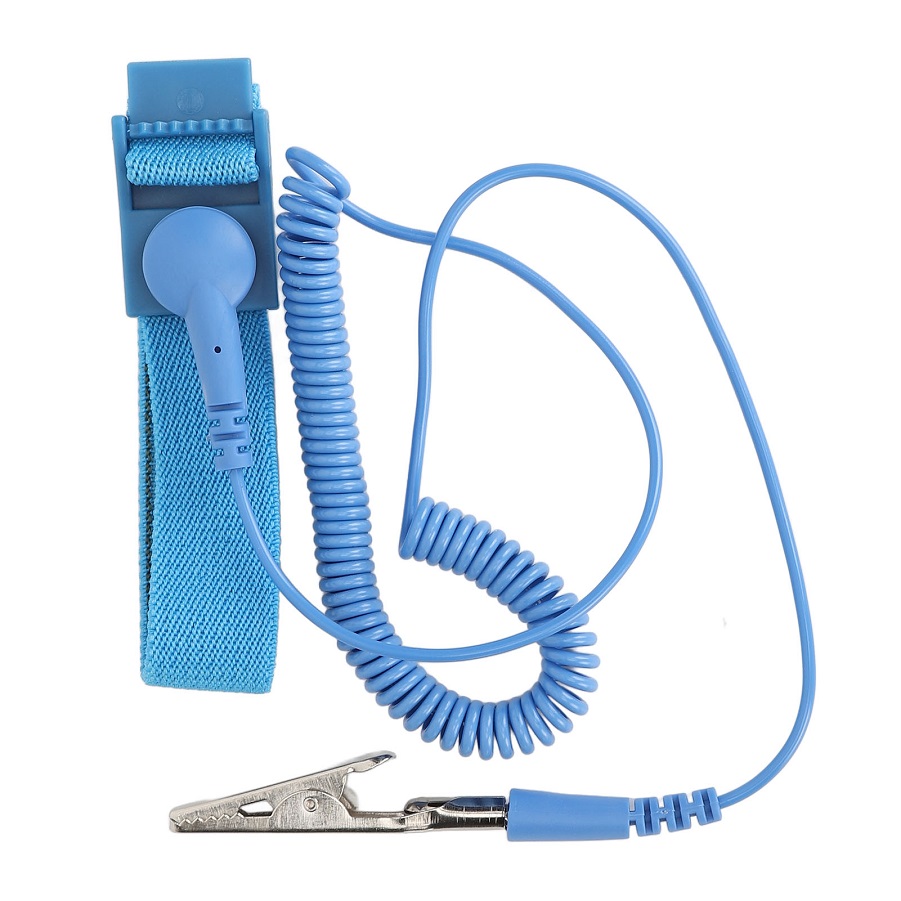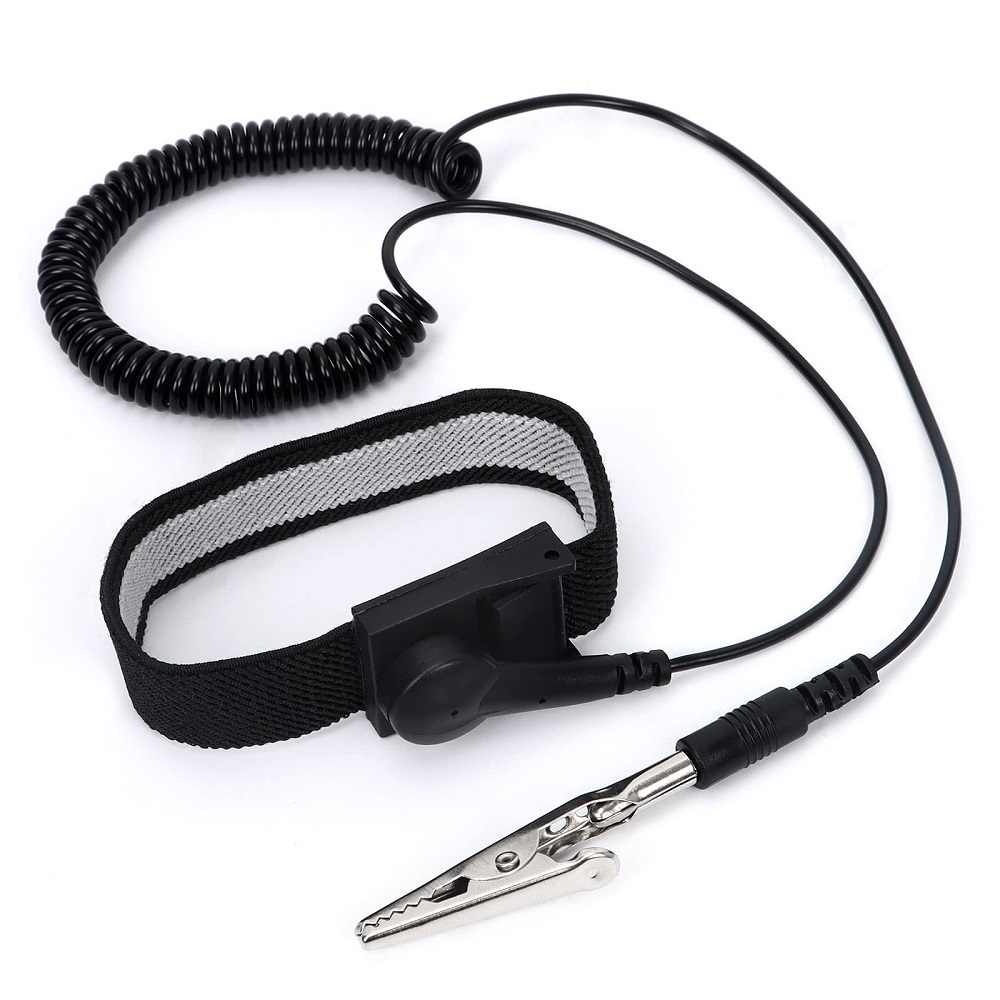The Importance of ESD Protection
Electrostatic Discharge, or ESD, is a silent hazard in electronics repair. Simple actions, like walking across a carpet, can generate static electricity. Without proper grounding, this static can transfer to your devices. This transfer can damage or destroy sensitive electronic components. An anti static wristband is a vital tool in preventing such damage.
It works by grounding you to a secure point while you work. This means any static from your body moves to the ground, not your devices. ESD protection is important for professionals and hobbyists alike. It extends the life of electronic devices. We can compare it to an insurance policy for your electronics. With a wristband, you work knowing you’re protecting your electronic investments.
Ignoring ESD protection can be a costly mistake. Repairs can turn into replacements quickly when ESD is not managed. Using an anti static wristband is a simple step. Yet, it has a significant impact on the success and safety of electronic repairs. Whether fixing a smartphone or assembling a PC, ESD protection through an anti static wristband is essential.
The use of an anti static wristband is a key practice in professional settings. Industry leaders like 3M highlight the dangers of ESD in their technical briefs. They emphasize rapid static dissipation is critical to prevent damaging voltage spikes. Just like seatbelts in cars, anti static wristbands serve as a standard safety measure in electronics work.

Features of an Effective Anti Static Wristband
When choosing an anti static wristband, several features ensure effectiveness:
- Material Quality: Look for a wristband with durable materials, like a polyester/stainless steel weave. This combination enhances longevity and maintains a good path for static discharge.
- Comfortable Design: A wristband should fit well to avoid distraction during work. It should have an adjustable buckle for a snug fit on different wrist sizes.
- Appropriate Cord Length: A coiled cord, ideally around 6 feet long, provides enough space to move freely. But it should be short enough to prevent tangling during repairs.
- Correct Resistance Level: The cord’s resistance is crucial. A 1 megohm (MΩ) resistor is a standard for safety, balancing protection with effective grounding.
- Ease of Use: The wristband should be easy to put on and secure to a grounded point. This makes the process of setting up quick and simple.
- Accessibility: Look for a wristband with a clip that easily attaches to a grounded surface. This feature reduces setup time and hassle.
A high-quality anti static wristband minimizes ESD risks effectively. It ensures a safe and productive environment for working on sensitive electronics. Remember to check for adjustable features, durability, ease of use, and proper resistance. These factors contribute to an effective ESD protection strategy.
How to Use an Anti Static Wristband for Electronic Repairs
Using an anti static wristband correctly is key to protecting your electronics. Here’s a step-by-step guide to ensure you’re using the wristband effectively:
- Wear the Wristband: Open the strap and place it around your wrist. Pull the strap through the buckle and adjust it for a snug fit. This shouldn’t be too tight but should ensure metal contact with your skin.
- Secure the Cord: Take the other end of the wristband, which has a clip or connective end. Attach this securely to a grounded metal object. This could be the metal frame of a workbench or a grounded metal surface.
- Test: Before starting your repairs, it’s good practice to test that the wristband is working. There are testing devices available that you can use to confirm connectivity.
- Begin Work: With the wristband securely in place and grounded, you can start your electronic repairs. Keep the wristband on and connected at all times while working.
- Move Freely But Carefully: The coiled cord allows you to move your hand freely. However, be aware of the cord’s length to avoid pulling it off from the grounding point.
Remember, an anti static wristband is a simple yet effective line of defense against ESD. It’s a small investment with huge returns for the lifespan of your electronics. Use it for every repair to ensure safety and efficiency.
Versatility in Applications: Electronics and Beyond
The usefulness of an anti static wristband stretches far beyond just electronics repairs. While the primary purpose remains to safeguard devices during repairs by preventing static electricity damage, these wristbands have broader applications in numerous industries where ESD sensitivity is a concern.
For those working in IT and data centers, using an anti static wristband when installing or servicing servers helps protect sensitive components. In telecommunications, precision is key, and the wristbands ensure that network equipment remains intact. Even in the automotive sector, modern vehicles with intricate electronic systems can benefit from ESD protection during diagnostic checks or electronic installations.

Beyond professional environments, hobbyists who enjoy building or repairing personal computers, creating circuitry for DIY projects, or tinkering with electronics find anti static wristbands invaluable. They’re essential tools for ensuring the successful completion of projects without the interference of ESD, thus protecting both the user’s investment and work.
Understanding that an anti static wristband is a multipurpose tool reinforces its value not only as an accessory for particular tasks but as a staple in any comprehensive toolkit. Whether it’s professional electronics repair, working in laboratory settings, or simply engaging in a personal tech hobby, an anti static wristband is crucial for maintaining the integrity of electronic components in numerous settings.
Essential Aspects of a Quality Anti Static Wristband
When scouting for a top-notch anti static wristband, several essential aspects should guide your choice:
- Optimal Size and Adjustability: An ideal band will fit all wrist sizes. It should have an adjustable buckle to ensure a secure grip without being too tight.
- Quality of Materials: Seek out bands made from durable materials, such as polyester combined with stainless steel weave. This blend is vital for both longevity and effective static discharge.
- Proper Grounding Cord Features: The wristband should feature a grounding cord that is both long enough to allow freedom of movement and coiled to avoid tangling. Look for a standard 6 feet length for optimal reach.
- Resistance Specification: The grounding cord should include a 1 megohm (MΩ) resistor. This resistance level strikes the right balance for safety and grounding effectiveness.
- Comfort During Use: The wristband’s design should not cause discomfort during use. Comfort ensures focus on the task, leading to better repair outcomes.
- Ease of Connection: A good anti static wristband should have a clip that’s easy to attach to a ground source. This helps in setting up your workspace quickly and efficiently.
Remember, a quality anti static wristband not only protects your electronics but also enhances your repair experience. Keep these aspects in mind to find a wristband that offers both safety and convenience.
Purchasing an Anti Static Wristband: What to Look For
Finding the right anti static wristband is key to effective ESD protection. There are specific features to consider before making a purchase. Look for these attributes:
- Compatible Size: Make sure the wristband is adjustable. It should fit snugly on any wrist size.
- Durable Materials: Choose a wristband made from a blend of polyester and stainless steel. This ensures longevity and effective static discharge.
- Appropriate Cord Length: The cord should be about 6 feet long. It allows for free movement and avoids tangling.
- Safety Resistance: Check that the cord includes a 1 megohm resistor. This is crucial for safe and effective grounding.
- Comfortable Design: The wristband should not irritate your skin or distract you during your work.
- Ease of Attachment: Opt for a wristband with a simple clip. You will connect it quickly to a ground source.
Keep these factors in mind when buying an anti static wristband. It should be efficient, comfortable, and easy to use. This simple tool is a wise investment for anyone working on electronic devices. It is essential for both durability and safeguarding sensitive components. With a proper wristband, you minimize the risk of costly ESD damage during repairs.
Maintaining Electronic Devices: How Anti Static Accessories Help
Protective measures are crucial when handling electronics. Anti static accessories, like wristbands, play a key role in maintaining device integrity. These accessories discharge static electricity safely. This protects electronics from electrostatic discharge (ESD) damage.
- Preventing Damage: Anti static wristbands prevent static build-up. Static can harm electronic components, leading to failure. These wristbands are vital for device longevity.
- Improving Repair Safety: Using an anti static wristband, you increase repair safety. It’s like a safety net for electronics, guarding against unexpected static shocks.
- Enhancing Lifespan: Devices last longer when shielded from ESD. Anti static accessories, hence, boost the lifespan of your gadgets.
- Cost-saving: Shielding electronics from static damage saves money. It avoids costly repairs or replacements due to ESD.
- Encouraging Professionalism: Professionals use ESD protection as a standard practice. It shows commitment to quality and careful work.
- Broad Use: Whether for personal or professional repairs, anti static wristbands assist. They help maintain various devices, from smartphones to large servers.
By investing in a quality anti static wristband, you are taking a step towards preserving your electronics. It demonstrates an understanding of the risks involved in repairs. It also shows a commitment to best practices in electronic device maintenance. Choose straps that fit well, are made of durable materials, and have the right resistance level. This ensures not only the safety of your devices but also your peace of mind while working on them.
FAQs About Anti Static Wristbands
When it comes to protecting your devices and ensuring safe electronic repairs, you might have questions about anti static wristbands. Below are frequently asked questions along with clear and concise answers.
What is the purpose of an anti static wristband?
An anti static wristband discharges static from your body. This helps to prevent ESD damage to electronics during repairs.
How does an anti static wristband work?
The wristband connects you to a ground point. It safely channels static electricity away from sensitive devices.
Can I use the wristband for any electronic repair?
Yes, it works for all types of electronic repairs. From smartphones to intricate circuit boards, it provides protection.
How do I wear an anti static wristband?
Wrap it around your wrist. Adjust it for a snug fit to maintain metal contact with your skin. Then, attach the clip to a grounded surface.
Is the wristband easy to use?
Very easy. Put it on, secure it to ground, and you’re set to work. It’s a simple tool with big benefits.
How long should the wristband’s cord be?
A cord about 6 feet long is best. It allows movement but is short enough to avoid tangling.
Why does the cord have a resistor?
The 1 megohm resistor is there for safety. It balances protection while grounding you effectively.
Using an anti static wristband is a small but essential action for any electronic repair job. It signals professionalism and a commitment to the quality of your work. It is a simple answer to the complex problems that static can cause. For anyone involved in electronics, this tool is a must-have in their kit.

